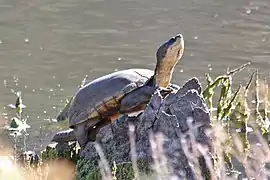Arizona mud turtle
The Arizona mud turtle (Kinosternon stejnegeri)[3] is a species of mud turtle in the family Kinosternidae. It is found in Arizona (United States) and Sonora (Mexico). It is considered a semi-aquatic turtle and is found in Desert of Arizona (United States) and Sonora (Mexico).[4] It lives in impermanent puddle, and they avoid permanent rivers and lakes.[5]
| Arizona mud turtle | |
|---|---|
 | |
| Scientific classification | |
| Kingdom: | Animalia |
| Phylum: | Chordata |
| Class: | Reptilia |
| Order: | Testudines |
| Suborder: | Cryptodira |
| Family: | Kinosternidae |
| Genus: | Kinosternon |
| Species: | K. stejnegeri |
| Binomial name | |
| Kinosternon stejnegeri (Gilmore, 1923) | |
| Synonyms[2] | |
| |
The male adult Arizona mud turtle is 103.0- 181.3 mm (4-7.5 in) long, and female Arizona mud turtle is slightly smaller than the male.[6] The turtle's top shell is brown and olive brown with a dome shaped appearance.[4] The skin is brown, dark silver on top, and light yellow on bottom of the head.[4] There are no specific pattern or stripes on extremities.[4]
The turtle's diet includes anurans, tadpoles, invertebrates and carrion.[7] Arizona mud turtle is only active during the day. It is active at night during summer in search of food. During winter Arizona mud turtle will hibernates under the temporary puddle and pond.[5]
The growth cycle begins in July and early August when the turtle starts laying eggs.[4] Except habitat loss, Arizona mud turtle often faces decrease in population due to agriculture activity. Fortunately, due to lack of water in the desert agriculture activity is minimized.[5]
Description
The male adult Arizona mud turtle is 103.0- 181.3 mm (4-7.5 in) long, and female Arizona mud turtle is 95.5-167.3mm (3.5-6.5 on) long.[5] The turtle's body varies in color. The carapace (upper portion of the shell) is dome shaped and tends to be brown, olive or a yellow-brown in color.[8][4] The carapace also lacks keels.[4] The marginal shields, which can be described as the rim around the shell is yellow.[8] In addition, the lower portion of the shell, also known as the plastron, is yellow as well.[8] The superior of the head is grey in color, and the inferior and the sides are cream and light yellow.[4] One thing that separates them from other species of turtles is that the first vertebral scute and second marginal shield do not connect.[8]
Habitat and behavior
Arizona mud turtles prefer temporary ponds and puddle because they will have a secured food source.[5] The Arizona mud turtle's activity occurs during the day.[8] It is often found near the temporary pond to conserve heat and energy from sunlight.[4] It also is active at night but specifically in July and August in monsoon season. Because it is warm during this period, they tend to spend most of their time in the water, hence why they are known as semi aquatic.[8] During the winter months, they hibernate in a burrow.[8] When drought occurs, Arizona mud turtle can remain dormant underground for maximum of two years.[4]
Distribution
Living in the lowland area, the Arizona mud turtle usually lives between the elevation of 200-800m.[5] The Arizona mud turtle can be located in the Lower Colorado River Sonoran Desert scrub, Arizona Upland Sonoran Desert scrub, and Semidesert Grassland communities.[8]
Diet
Their diet consists of anurans, dytiscid, toads, tadpoles, fish, invertebrates, hydrophilid and carrion.[7]
Life cycle
The female Arizona mud turtle lays three to seven eggs and mates primarily in July till early August.[4] Arizona mud turtle does not have a special nesting habits, and it usually hatch and bury its eggs close to the food sources.[9] Hatchlings are usually 25–28 mm carapace length and have life span from 6 to 10 years age.[10]
Major threats
The species is considered threatened, because there has been ranching, agriculture and flood control taking place in the Sonoran Desert.[10] Establishing themselves in wetlands also exposes them to climate and habitat degradation.[10] An adult Arizona mud turtle usually will survive these conditions, however. Road mortality is also likely to affect this species.[10] On the positive side, the Arizona mud turtle adapts and benefits from pond reconstruction performed by humans.[10]
References
- Frost, D.; Hammerson, G. & Gadsden, H. (2007). "Kinosternon arizonense". The IUCN Red List of Threatened Species. 2007: e.T63666A97379712. doi:10.2305/IUCN.UK.2007.RLTS.T63666A12694945.en.
- Fritz Uwe; Peter Havaš (2007). "Checklist of Chelonians of the World" (PDF). Vertebrate Zoology. 57 (2): 251. ISSN 1864-5755. Archived from the original (PDF) on 2010-12-17. Retrieved 29 May 2012.
- Rhodin, Anders G.J.; Inverson, John B.; Roger, Bour; Fritz, Uwe; Georges, Arthur; Shaffer, H. Bradley; van Dijk, Peter Paul (August 3, 2017). "Turtles of the world, 2017 update: Annotated checklist and atlas of taxonomy, synonymy, distribution, and conservation status(8th Ed.)" (PDF). Chelonian Research Monographs. 7: 222. ISBN 978-1-5323-5026-9. Retrieved October 4, 2019.
- "Arizona Mud Turtle - Tucson Herpetological Society". Tucson Herpetological Society. Retrieved 2018-10-25.
- Iverson, John B. (September 1989). The Arizona Mud Turtle, Kinosternon flavescens arizonense (Kinosternidae), in Arizona andSonora. Southwestern Association of Naturalists. pp. 356–368.
- McCord, Robert D. (2016). "What is Kinosternon arizonense?". Historical Biology. 28:1-2 (1–2): 310–315. doi:10.1080/08912963.2015.1053879.
- Brennan, Thomas. "ARIZONA MUD TURTLE Kinosternon arizonense". Retrieved 10 August 2013.
- Brennan, Thomas. "ARIZONA MUD TURTLE Kinosternon arizonense". Retrieved 10 August 2013.
- Ligon, Day B.; Peterson, Charles C. (September 2002). "Physiological and Behavioral Variation in Estivation among Mud Turtles (Kinosternon spp.)". Oklahoma State University: 283–293.
- Frost, D.; Hammerson, G. & Gadsden, H. "Arizona Mud Turtle". IUCN Red List of Threatened Species. Retrieved 13 August 2013.
